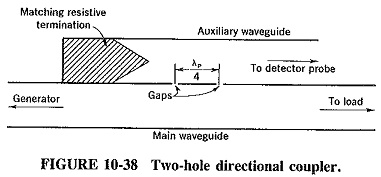Directional Coupler Waveguide:
We already know that a transmission-line Directional Coupler Waveguide. Its applications were indicated at the time as being unidirectional power flow measurement, SWR measurement and unidirectional wave radiation. Exactly the same considerations apply to waveguides.
Several directional couplers for waveguides exist, and the most common ones will be described, including a direct counterpart of the transmission-line coupler, which is also commonly used with waveguides. It should also be mentioned that the hybrid T junction and hybrid ring are not normally classified as directional couplers.
Two Hole Directional Coupler:
The coupler of Figure 10-38 is the waveguide analog of the transmission-line coupler of Figure 7-19. The operation is also almost identical, the only exceptions being that the two holes are now λp/4 apart, and a different sort of attenuator is used to absorb backward wave components in the auxiliary guide.
This is a very popular waveguide directional coupler. It may also be used for direct SWR measurements if the absorbing attenuator is replaced by a detecting device, for measuring the components in the auxiliary guide that are proportional to the reflected wave in the main waveguide. Such a directional coupler is called a reflectometer, but because it is rather difficult to match two detectors, it is often preferable to use two separate directional couplers to form the reflectometer.
Other types:
Other directional couplers include one type that employs a single slot (with two waveguides having a different orientation). There are also a directional coupler with a single long slot so shaped that directional properties are preserved and another type which uses two slots with a capacitive coaxial loop through them.
There are a series of couplers similar to the two-hole coupler, but with three or more holes in the common wall. If three holes are used, the center one generally admits twice as much power as the end holes, in an attempt to extend the bandwidth of such a coupler. The two-hole coupler is directional only at those frequencies at which the hole separation is nλp/4, where n is an odd integer.
